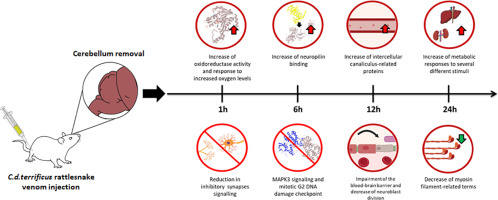当前位置:
X-MOL 学术
›
J. Proteomics
›
论文详情
Our official English website, www.x-mol.net, welcomes your
feedback! (Note: you will need to create a separate account there.)
The impact of rattlesnake venom on mice cerebellum proteomics points to synaptic inhibition and tissue damage.
Journal of Proteomics ( IF 2.8 ) Pub Date : 2020-04-07 , DOI: 10.1016/j.jprot.2020.103779 Fabio Montoni 1 , Diana Zukas Andreotti 2 , Rosangela Aparecida Dos Santos Eichler 2 , Wellington da Silva Santos 1 , Carolina Yukiko Kisaki 1 , Stephanie Santos Suehiro Arcos 1 , Ismael Feitosa Lima 1 , Magna Aparecida Maltauro Soares 3 , Milton Yutaka Nishiyama-Jr 1 , Daniel Nava-Rodrigues 4 , Emer Suavinho Ferro 2 , Valdemir Melechco Carvalho 5 , Leo Kei Iwai 1
Journal of Proteomics ( IF 2.8 ) Pub Date : 2020-04-07 , DOI: 10.1016/j.jprot.2020.103779 Fabio Montoni 1 , Diana Zukas Andreotti 2 , Rosangela Aparecida Dos Santos Eichler 2 , Wellington da Silva Santos 1 , Carolina Yukiko Kisaki 1 , Stephanie Santos Suehiro Arcos 1 , Ismael Feitosa Lima 1 , Magna Aparecida Maltauro Soares 3 , Milton Yutaka Nishiyama-Jr 1 , Daniel Nava-Rodrigues 4 , Emer Suavinho Ferro 2 , Valdemir Melechco Carvalho 5 , Leo Kei Iwai 1
Affiliation

|
Snake envenomation is responsible for more than 130,000 deaths worldwide. In Brazil, the Crotalus rattlesnake is responsible for the second largest number of accidental snake bites in the country. Although there are many descriptions of the clinical and biochemical effects of Crotalus envenoming, there are few works describing the molecular events in the central nervous system of an organism due to envenomation. In this study, we analyzed the proteomic effect of Crotalus durissus terrificus snake venom on mice cerebellums. To monitor the envenomation over time, changes in the protein abundance were evaluated at 1 h, 6 h, 12 h and 24 h after venom injection by mass spectrometry. The analysis of the variation of over 4600 identified proteins over time showed a reduction in components of inhibitory synapse signaling, oxidative stress, and maintenance of neuronal cells, which paralleled increasing tissue damage and apoptosis factors. These analyses revealed the potential protein targets of the C. d. terrificus venom on the murine cerebellum, showing new aspects of the snake envenomation effect. These data may contribute to new therapeutic approaches (i.e., approaches directed at protein targets affected by the envenomation) on the treatment of envenomation by the neurotoxic C. d. terrificus snake venom. SIGNIFICANCE: Snakebites are a neglected global health problem that affects mostly rural and tropical areas of developing countries. It is estimated that over 5.4 million people are bitten by snakes each year, from which 2.7 million people are bitten by venomous snakes, resulting in disabilities such as amputations and in some cases leading to death. The C. d. terrificus snake is the most lethal snake in Brazil. Studying the molecular changes upon envenomation in a specific tissue may lead to a better understanding of the envenomation process by C. d. terrificus snakebites.
更新日期:2020-04-08











































 京公网安备 11010802027423号
京公网安备 11010802027423号